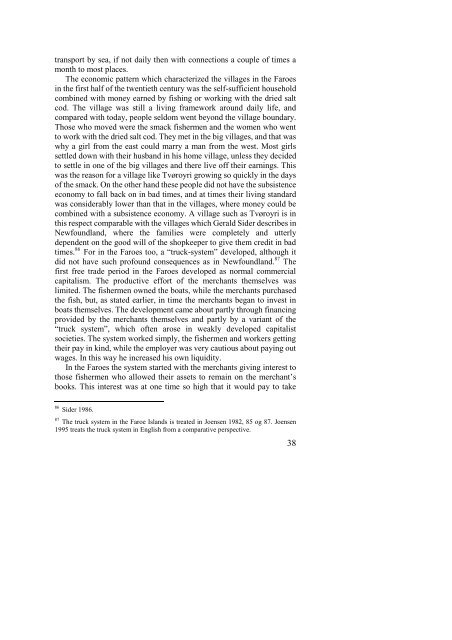The North Atlantic Fisheries, 1100-1976 - University of Hull
The North Atlantic Fisheries, 1100-1976 - University of Hull
The North Atlantic Fisheries, 1100-1976 - University of Hull
You also want an ePaper? Increase the reach of your titles
YUMPU automatically turns print PDFs into web optimized ePapers that Google loves.
transport by sea, if not daily then with connections a couple <strong>of</strong> times a<br />
month to most places.<br />
<strong>The</strong> economic pattern which characterized the villages in the Faroes<br />
in the first half <strong>of</strong> the twentieth century was the self-sufficient household<br />
combined with money earned by fishing or working with the dried salt<br />
cod. <strong>The</strong> village was still a living framework around daily life, and<br />
compared with today, people seldom went beyond the village boundary.<br />
Those who moved were the smack fishermen and the women who went<br />
to work with the dried salt cod. <strong>The</strong>y met in the big villages, and that was<br />
why a girl from the east could marry a man from the west. Most girls<br />
settled down with their husband in his home village, unless they decided<br />
to settle in one <strong>of</strong> the big villages and there live <strong>of</strong>f their earnings. This<br />
was the reason for a village like Tvøroyri growing so quickly in the days<br />
<strong>of</strong> the smack. On the other hand these people did not have the subsistence<br />
economy to fall back on in bad times, and at times their living standard<br />
was considerably lower than that in the villages, where money could be<br />
combined with a subsistence economy. A village such as Tvøroyri is in<br />
this respect comparable with the villages which Gerald Sider describes in<br />
Newfoundland, where the families were completely and utterly<br />
dependent on the good will <strong>of</strong> the shopkeeper to give them credit in bad<br />
times. 86 For in the Faroes too, a “truck-system” developed, although it<br />
did not have such pr<strong>of</strong>ound consequences as in Newfoundland. 87 <strong>The</strong><br />
first free trade period in the Faroes developed as normal commercial<br />
capitalism. <strong>The</strong> productive effort <strong>of</strong> the merchants themselves was<br />
limited. <strong>The</strong> fishermen owned the boats, while the merchants purchased<br />
the fish, but, as stated earlier, in time the merchants began to invest in<br />
boats themselves. <strong>The</strong> development came about partly through financing<br />
provided by the merchants themselves and partly by a variant <strong>of</strong> the<br />
“truck system”, which <strong>of</strong>ten arose in weakly developed capitalist<br />
societies. <strong>The</strong> system worked simply, the fishermen and workers getting<br />
their pay in kind, while the employer was very cautious about paying out<br />
wages. In this way he increased his own liquidity.<br />
In the Faroes the system started with the merchants giving interest to<br />
those fishermen who allowed their assets to remain on the merchant’s<br />
books. This interest was at one time so high that it would pay to take<br />
86 Sider 1986.<br />
87 <strong>The</strong> truck system in the Faroe Islands is treated in Joensen 1982, 85 og 87. Joensen<br />
1995 treats the truck system in English from a comparative perspective.<br />
38















